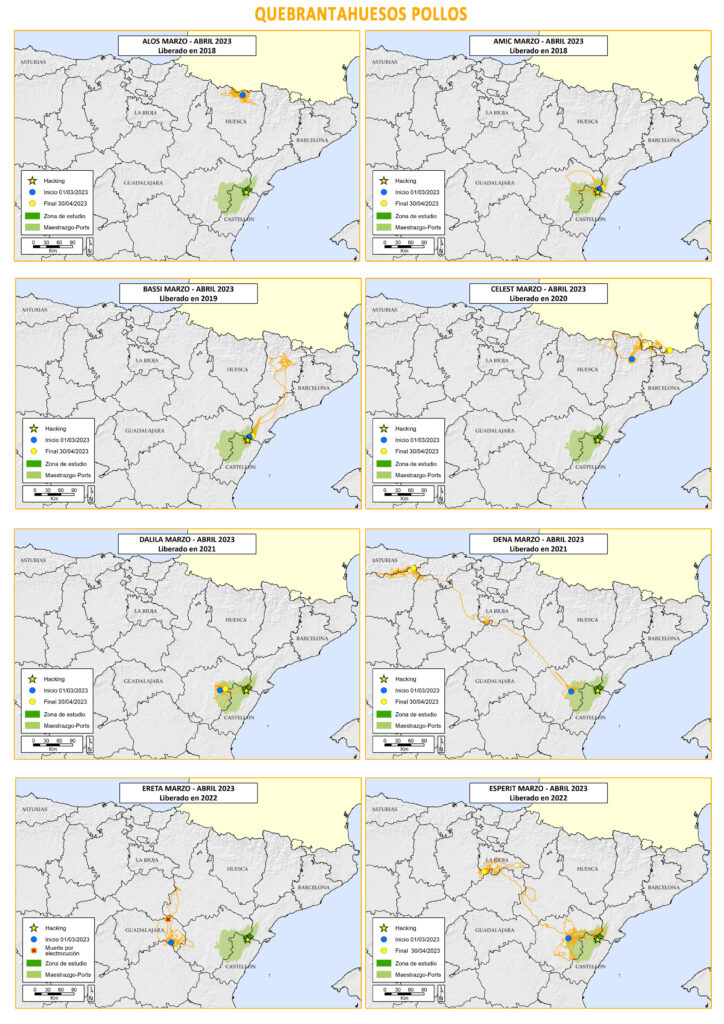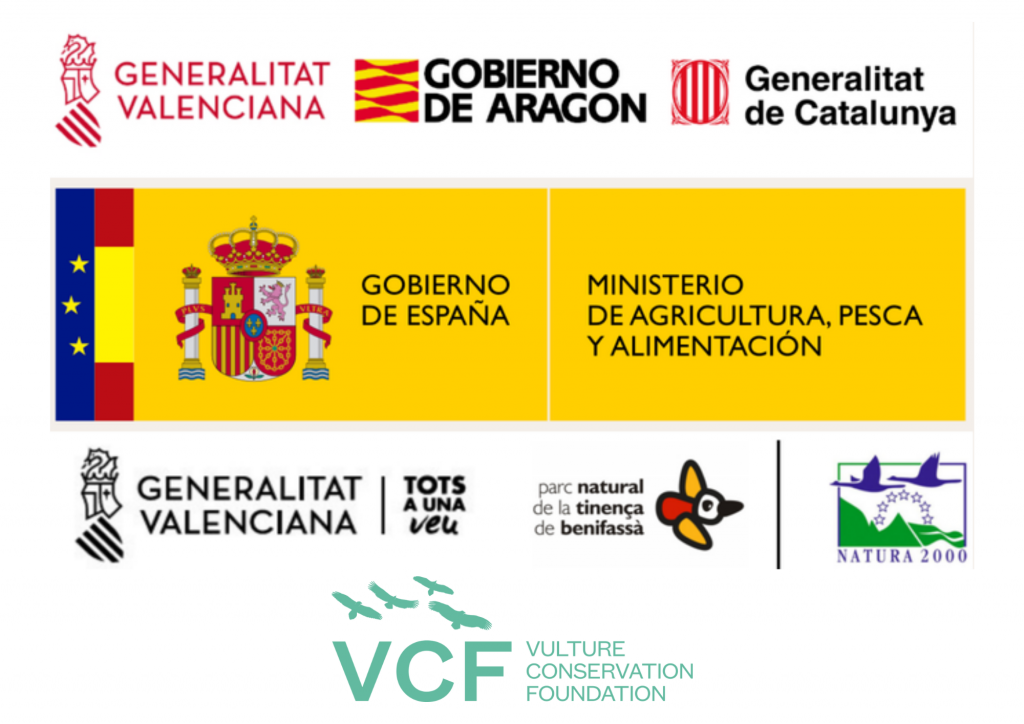On 2 June, three juvenile Bearded Vultures released in Parc Natural de la Tinença de Benifassà were received by dozens of curious people and partnering organisations. The effort to bring the Bearded Vulture back to Maestrazgo is now in its 5th year, thanks to the straight collaboration between the Vulture Conservation Foundation (VF), the Spanish Ministry for Ecological Transition, and the Regional Governments of Valencia, Aragon and Catalonia.

Bringing the Bearded Vulture back to Maestrazgo
Since 2018, the Vulture Conservation Foundation has been working with the Government of Spain, Generalitat Valenciana, Generalitat Catalonia and Gobierno de Aragon to establish a thriving breeding population in Maestrazgo. Historically an important breeding site for the species, a new breeding nucleus in Maestrazgo would mean an essential step in connecting the Andalusian and Pyrenean Bearded Vulture populations.
With the new juveniles released last week, a total of 14 Bearded Vultures have been released following the “hacking method”. The juveniles that have arrived now at the hacking facilities in Parc Natural de la Tinença de Benifassà are not yet able to fly. Over the coming weeks, they will master their flying skills and leave the artificial nests, a method that mimics their natural way of fledging.


Meet the three Bearded Vultures released in Maestrazgo
Two females and one male Bearded Vulture were released in Maestrazgo and are currently in the hacking facilities at the Parc Natural de la Tinença de Benifassà, managed by Generalitat Valenciana. One of the females hatched in the Richard Faust Specialized Breeding Centre, in Austria, on 28 February. Some days before the release, the bird was transferred to Guadalentín Breeding Centre to be transported with the other two juveniles. Both the male, BG 1174 and the second female, BG 1177, hatched in the Guadalentín Specialized Breeding Centre, descending from the pair Viola and Elías. BG 1174 was welcomed by the parents on 5 March, whilst the female hatched on 3 March was adopted and reared by another pair, Sabina and Tranco, on 12 March.
It is a common practice to hand-rear the newborn during the first days. After that, to avoid human imprinting, the chicks are either returned to their parents or adopted by foster parents. The aim is to prevent losing chicks, as Bearded Vultures have an instinctive condition, called cainism, to attack and kill their siblings, even when no food shortages occur. The adoption by another pair or individual is the most effective way to ensure their survival. Managed by us at the VCF, under a cooperation agreement with Junta de Andalusia, Guadalentín is the Guadalentín is the centre where most of the breed chicks are used in reintroduction projects within the Bearded Vulture Captive Breeding Network.

Where are the Bearded Vultures previously released in Maestrazgo?
Earlier this month, we shared an update on the last movements of all Bearded Vultures released, thanks to the GPS data we receive with their real-time locations. Of the 11 Bearded Vultures released, unfortunately, two individuals died in the sequence of Golden Eagle attacks, Cocó released in 2020 and Durall, released in 2021, and Ereta, released in 2022, was unfortunately electrocuted in March this year, close to Guadalajara. Boira, whose GPS connection was lost a couple of months ago, was recently seen at the Boumort National Reserve in Catalonia.

Establishing a breeding population takes time and patience. Bearded Vultures are long-lived species that take 5 to 7 years to reach sexual maturity. Breeding success usually occurs from the age of 8 onwards, and in the wild, all reintroduction projects in areas where the species was extinct, took more than nine years to see the first wild hatchlings.
Captive breeding is fundamental in securing a future for Bearded Vultures in Europe.
The Bearded Vultures we release into the wild come from a captive breeding background, hatching in different facilities within the Bearded Vulture Vulture Captive Breeding Network, managed by us on behalf of EAZA’s European Endangered Species Programme (Bearded Vulture EEP). Once the captive-bred vultures are around 90 days old, they are released into priority areas where the species have disappeared or are threatened.
Before release, the vultures are equipped with identification rings and GPS transmitters, and a unique set of their feathers are bleached to monitor their movements and progress in the wild while also evaluating our conservation efforts. As youngsters, they often travel vast distances and explore new regions, but when they become sexually mature, they tend to select areas to breed near where they fledged. This is why acclimatisation in hacking facilities is such an important step.
Fundación para la Conservación del Quebrantahuesos suspends Bearded Vulture releases in Maestrazgo
Fundación Quebrantahuesos (FCQ) recently announced that the reintroductions foreseen in the LIFE Project “Iberian Corridors for the Bearded Vulture” were precautionarily suspended. The decision results from an impact study on the risk of collision with wind turbines, as a new wind farm is foreseen in the region of Maestrazgo, Teruel, close to the potential release area. These could result in a massive impact on the released Bearded Vultures, as 368 wind turbines of 158 m each are planned to be installed, apart from the power lines required.
Wind farms pose a growing threat to Bearded Vultures and other large-bodied birds. Shutdown on demand (SDOD) is currently the most effective way to tackle the threat, but new technological approaches, such as camera detection, are being tested. Would the installation of this new wind farm pose a danger to the Bearded Vultures already released? According to Àlex Llopis, VCF Captive Breeding Programme Coordinator, the location foreseen would not directly impact the individuals we have recently released.
We wish the juvenile Bearded Vultures good luck in their new home!





